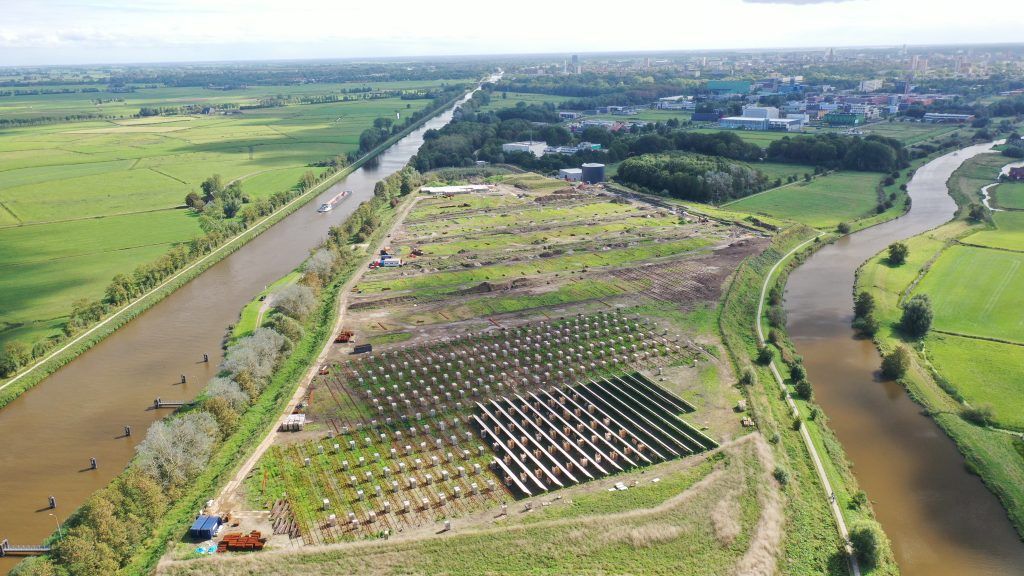
In addition to generating electricity, the sun can also be put to good use in heating homes. This technique, called solar thermal, is applied by Novar, TVP Solar and area developer K3 in Dorkwerd, Groningen, where the largest solar thermal park in the Netherlands is located.
Solar thermal energy is still in its infancy in the Netherlands, but it is being used in more and more places. Zonthermie is an innovative way to convert heat from the sun into heat that can be used at home. The technique works as follows: solar collectors heat water flowing through the panels. This temperature rises to 85 to 90 degrees Celsius. If there is no direct heat demand from the heat network, the heat is first stored in a day buffer. Then the heat is transferred via a heat exchanger to the transport pipeline to Warmtestad's heat plant. Warmtestad then distributes this heat through a heat grid to homes in the city.
There are currently two projects in the Netherlands where solar thermal is combined with a heat grid. One of these projects is the Zonthermiepark Dorkwerd. The scale of the project is unique: the project will be connected to the local heat grid with 24,000 solar collectors in the first six months of 2024 and is good for heating about 2,600 homes. The project thus fills 40 percent of the heat grid's total heat demand in the first few years. This percentage will begin to decline as the heat grid expands. According to Bas Bolomey, business unit developer heat at Novar, WarmteStad, the developer of the heat grid, plans to grow to about 10,000 connected homes by 2030. Residual heat from a nearby data center and a thermal energy storage (WKO) system will supply the remaining heat demand of the Groningen heat grid.
The heat generated by the solar thermal farm can be delivered directly to the heat grid. However, it can also be stored in a buffer tank. In this way, the heat can also be used in the evenings and mornings to heat homes. Warmtestad's heat plant is also connected to seasonal storage. When heat demand is higher in the winter, there is still enough heat available.
"Large-scale solar thermal is still in its infancy in the Netherlands, but should definitely join the playing field."
One of the advantages of solar thermal is that the yield per square meter is higher than solar panels and wind power. In addition, it can be easily incorporated into existing heat networks. Solar thermal is also very sustainable: it has the sun as an inexhaustible source, and, when the generation site is close to the heat grid, little pumping energy is needed to bring the water to the homes. In that case, solar heat is virtually carbon-free.
The disadvantage of solar thermal is that the energy output is seasonal and weather dependent. Solar thermal is therefore often used in combination with an additional heat source or seasonal storage. However, Bas does not see this in a negative light: "Traditionally, one source is looked at for one heat demand; this thinking comes from the fossil era. A sustainable heat supply requires a combination of sources. It is challenging to apply solar thermal as a mono-source, which is why little has been done in the past. But when you combine different sources, solar thermal is very suitable."
Solar thermal is still an understudy compared to solar power because it is a lot less known. This unfamiliarity causes reluctance on the part of some installers. Partly because of this, solar thermal has not been growing in the Netherlands for years.
Bas also sees a lot of potential in solar thermal compared to solar power: "The advantage of using a solar farm for solar thermal is that there is no grid congestion. You still use the sun as a sustainable source, but you solve another problem. The Netherlands is already well on its way to making its electricity more sustainable, but making heat supply more sustainable is still in its infancy."
Bas is also realistic: "Solar thermal is not always the best solution, but it should certainly compete in the playing field. Geothermal, aquathermy or waste heat is not always available and there are disadvantages to that. Solar thermal can be a good solution and should certainly be considered. However, other renewable heat sources have a better lobbying position. To create a level playing field, the system to grow solar thermal needs to grow. Currently, for example, solar thermal is not yet adequately supported in the SDE."
This article previously appeared in Solar Solutions Amsterdam's Solar Trend Report 2024.
